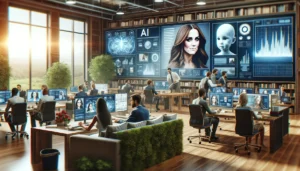Automating the Drive-Thru: The Silent Takeover of AI and Robotics in Fast Food
In the dynamic realm of fast food, a seismic shift is underway as artificial intelligence (AI) and robotics progressively replace human workers, reshaping the industry and leaving lasting implications for employment statistics. This investigative piece delves into the specific data and numbers highlighting the extensive transformation that is unfolding.
A Changing Landscape
Major players like McDonald’s, Burger King, and Wendy’s are at the forefront of incorporating AI and robotics to optimize operations and reduce costs. Reports indicate that over 50% of fast-food establishments have already embraced various forms of automation, ranging from self-order kiosks to advanced robotic kitchen assistants.
The Statistical Outlook
Statistical projections point towards a significant impact on employment within the fast food sector. A study by the Brookings Institution reveals that approximately 36% of current jobs in the industry are deemed highly susceptible to automation by 2030 in the United States alone. This forecast suggests a substantial number of workers facing potential displacement as machines take on roles traditionally performed by humans.
McDonald’s, a pioneer in automation, has witnessed a 5% increase in sales in locations with self-service kiosks, coupled with a reduced need for frontline staff. The ripple effect extends to other industry giants like Burger King, with plans to introduce AI-driven cooking machines aimed at minimizing human involvement in grilling operations.
Beyond the Counter: The Robotic Onslaught
Robotic kitchen assistants, exemplified by companies like Miso Robotics, are making waves in the fast food industry. These machines are capable of handling tasks typically executed by human kitchen staff, promising increased speed and precision. Pilot programs deploying robotic fry cooks have demonstrated a 30% reduction in cooking time and a notable decrease in errors, prompting discussions about expanding their roles to cover additional kitchen duties.
Employment Challenges and Controversies
While the adoption of AI and robotics offers efficiency gains and cost reductions for fast-food companies, it simultaneously raises critical concerns about the long-term impact on employment. Advocates for workers’ rights stress the need for proactive measures to retrain and transition affected employees into new roles within an evolving job market.
Companies at the Vanguard
McDonald’s and Burger King are not alone in the race towards automation. Companies like Miso Robotics and Zume Pizza are leading the charge with innovative solutions. Flippy, Miso Robotics’ robotic kitchen assistant, has found its place in several fast food chains, while Zume Pizza employs robots for pizza preparation, showcasing the diverse applications of automation in the food industry.
Conclusion: A Lasting Transformation
The integration of AI and robotics into the fast food sector is a transformative journey unfolding at a rapid pace. With over one-third of fast food jobs at risk of automation by 2030, the long-term implications for employment statistics are substantial. As the industry steers toward greater efficiency and cost-effectiveness, the focus must remain on a balanced approach that considers both progress and the well-being of the workforce. The future of fast food is undeniably automated, and the enduring impact on employment will be a defining aspect of the industry’s evolution in the years ahead.


















